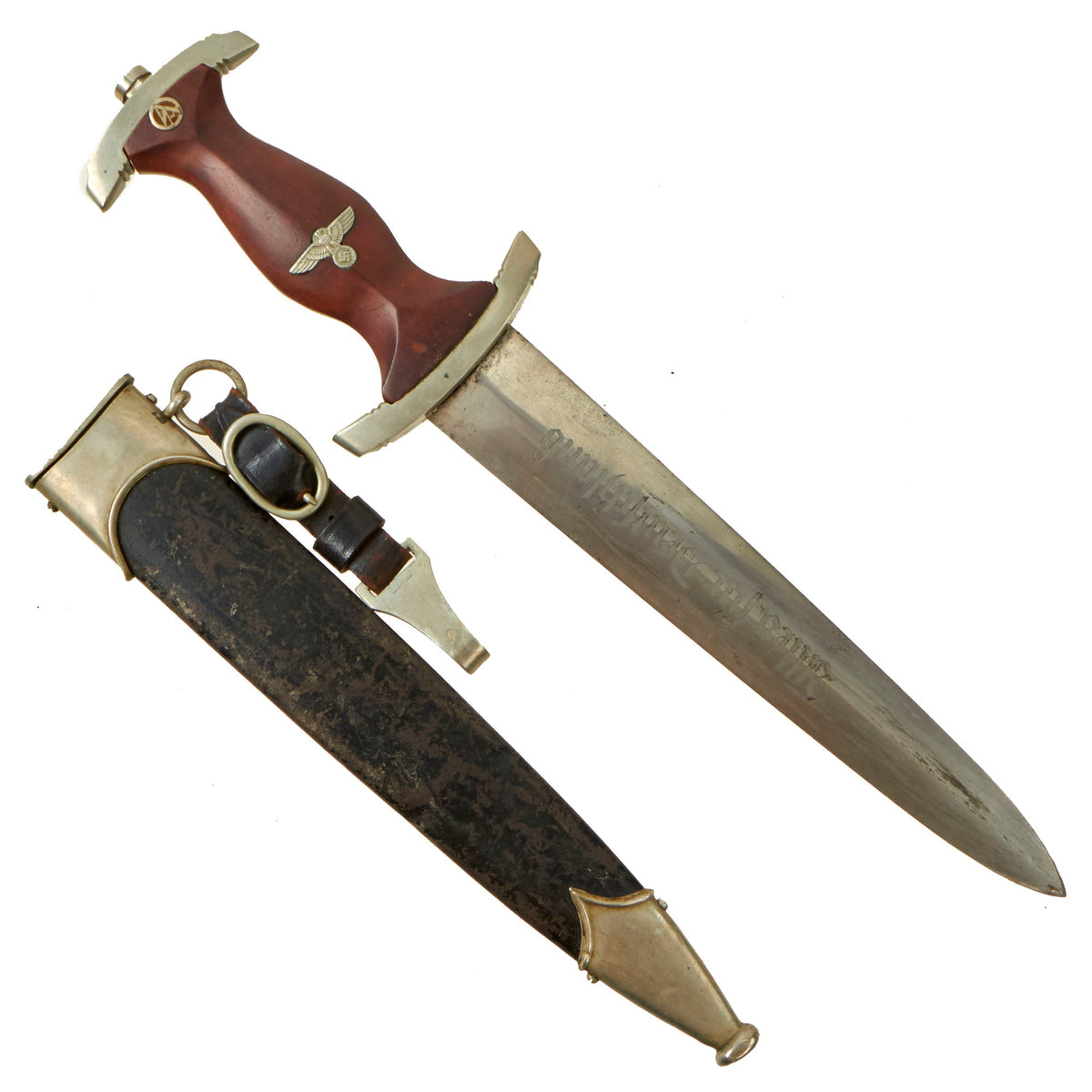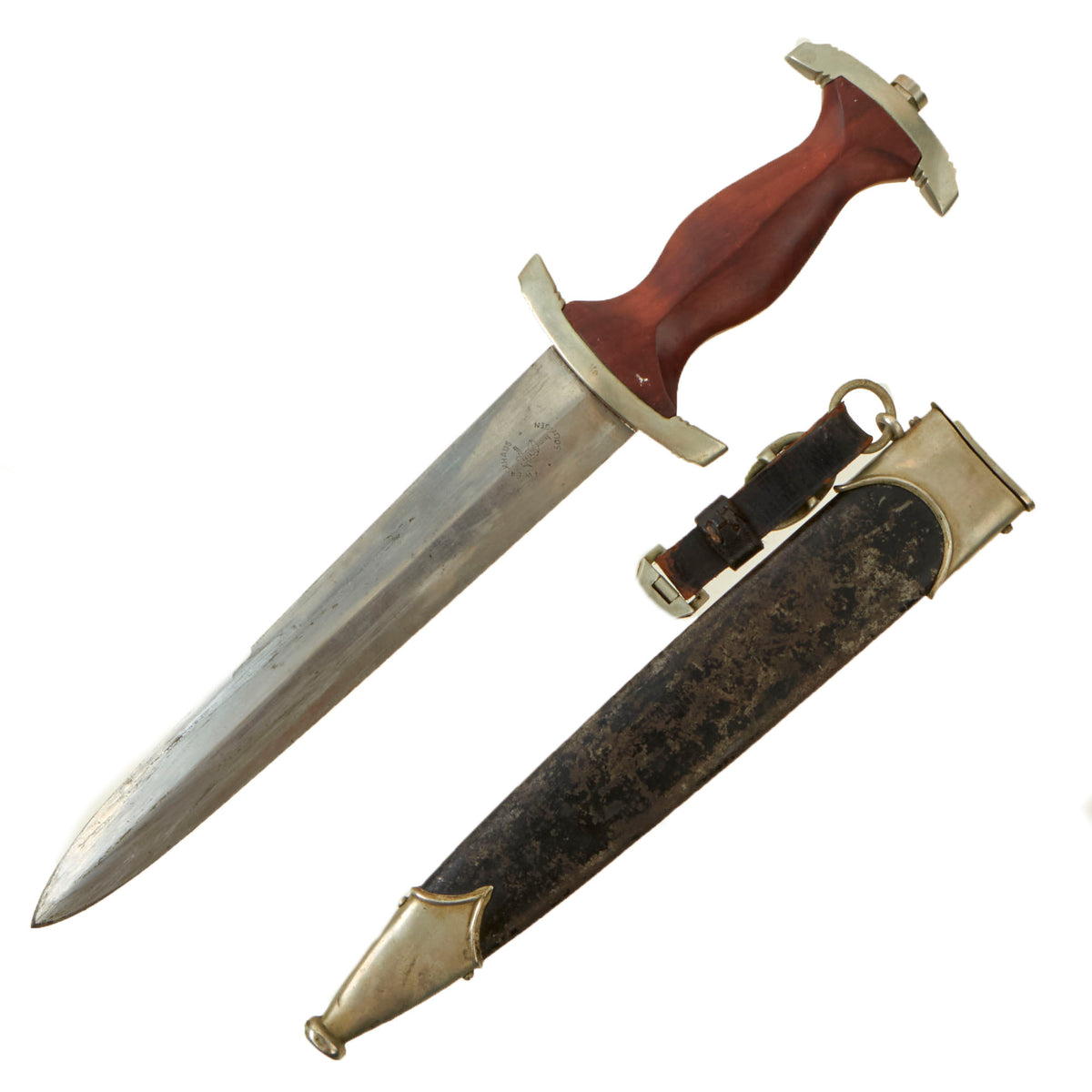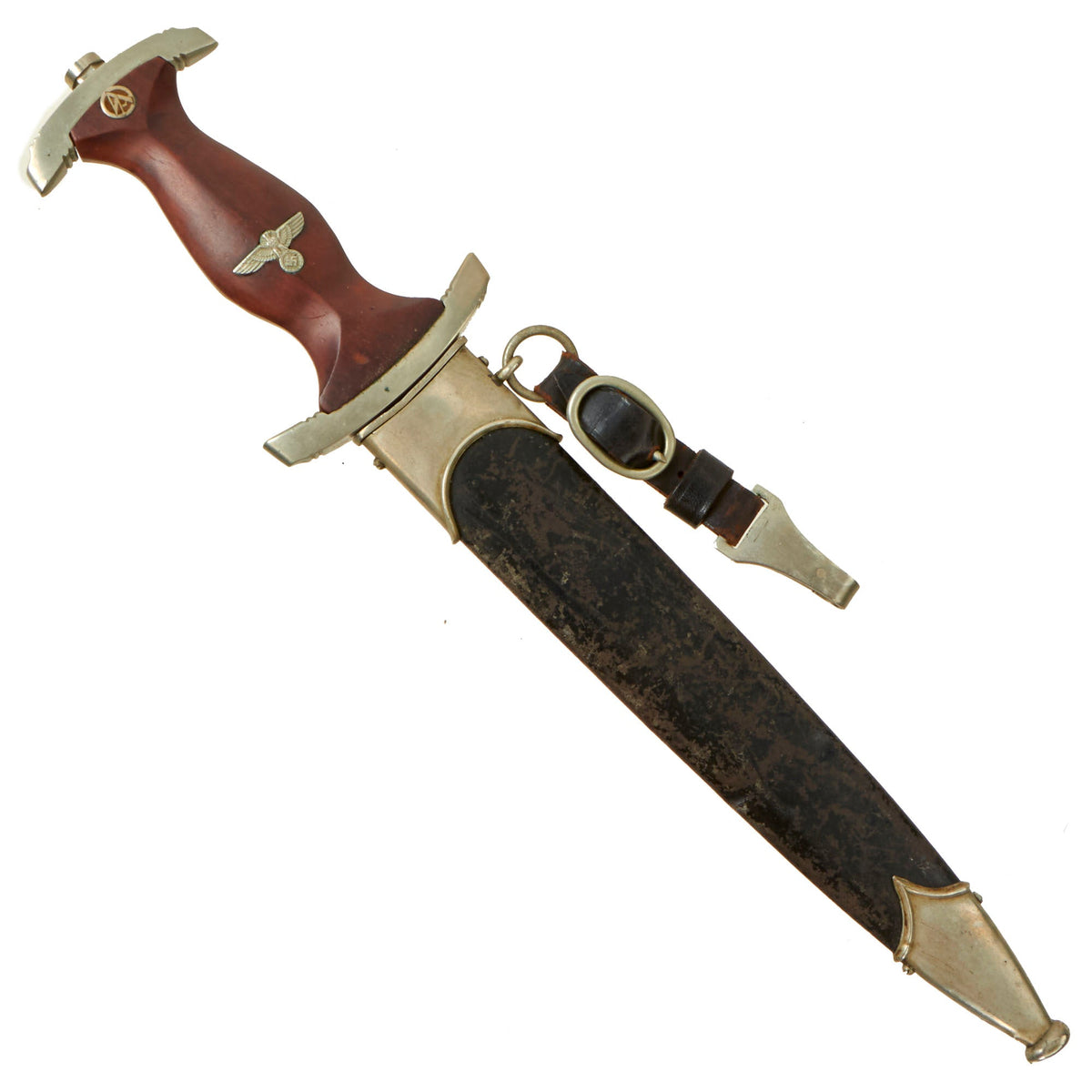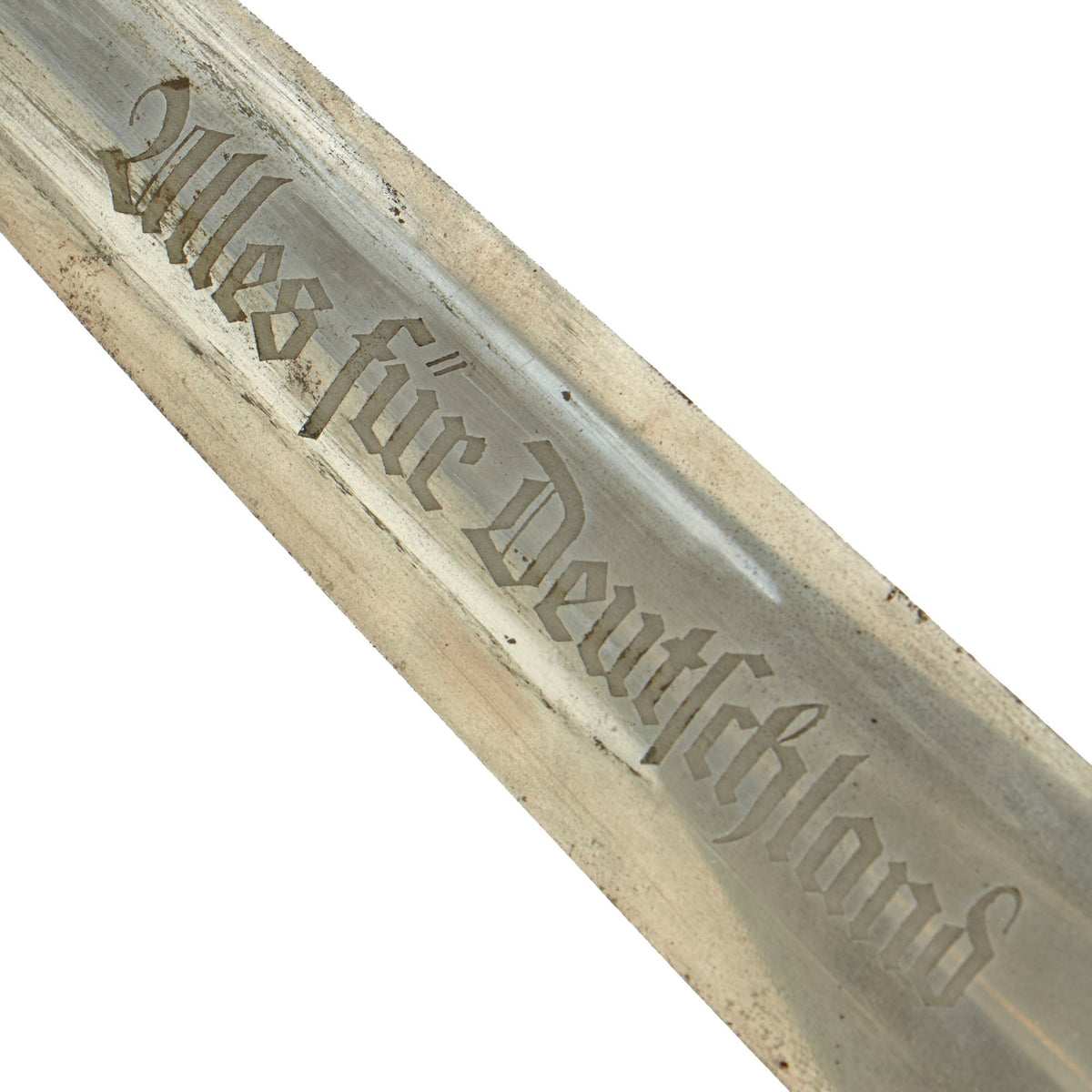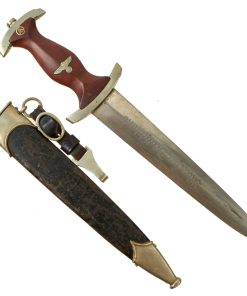Original German Early WWII NSKK Dagger by Rare Maker F. W. Backhaus with Re-Tipped Blade, Scabbard & Hanger – McSARR Rarity Rated 7 of 10 Original Items
$ 895,00 $ 223,75
Original Item: Only One Available. This is a very good condition early pattern NSKK Dagger, made by the very rare maker F.W. Backhaus GmbH, Stahlwarenfabrik (Steelwares Factory), located in Solingen, Germany. This is only the second item of any kind we have had by this maker, and they only made NSKK/SA daggers for a relatively short time. This maker is rated 7 out of 10 for rarity on the McSARR (McAlvanah SA Rarity Rating) scale, assembled based on 18,000 SA & NSKK daggers as seen by Mike McAlvanah. Makers of this rarity are extremely desirable and sought after by collectors. The blade on this example is in very good condition, though the tip has been reprofiled, and the dagger comes complete with an original repainted scabbard.
The dagger has solid nickel silver fittings throughout, and is a really nice example. The cross guards and tang nut are in very good condition throughout with all fittings having a nice lightly aged patina. There is no chipping or flaking, showing that they are indeed solid nickel alloy. The lower reverse guard is Gruppe/Gau marked He, for Hessen, a district in the west of Germany, with the principal city being Frankfurt. This feature was only seen on daggers produced 1935 and prior. The non-magnetic alloy pommel nut is in very good shape, showing just a bit of turning, and the hilt is still tight on the blade.
The grip is a fine product having a nice deep red brown color, with a medium center ridge construction. This grip is in good condition and fits the crossguards nicely, with no wobble we can feel. It has a lovely grain pattern, and shows a lot of “depth” or chatoyancy in the wood fibers. There are no chunks missing, however it does have hairline cracks on both sides that run to the pommel. On the obverse it looks to run all the way from the symbol to the eagle. The symbol button is nicely set, and still has almost all of the translucent enamel intact. The grip eagle is a fine example being the style with beak that points straight. The details are still there to the eagle to include the beak, breast feathering, wing feathering, talons, wreath and mobile swas. There is a bit of wear, showing that is the correct solid nickel silver for an early pattern eagle.
The reverse of the blade is maker marked with the “Baby on the back of a stork” trademark logo of F.W. Backhaus GmbH, Stahlwarenfabrik (Steelware Factory) of the Ohligs borough of Solingen, surrounded by their name and address:
F. W. BACKHAUS
+ (Logo) +
SOLINGEN
This metalworking business was founded in 1827 by Freidrich Wilhelm Backhaus, and first registered trademarks in 1854, and again in 1875 by the founders son. The company went on to produce combat knives during the First World War. During the third reich period they made SA, SS, and NSKK daggers, as well as HJ knives. Only the earliest production examples bear the “baby-and-stork” trademark, per J. Anthony Carter’s fine work GERMAN SWORD AND KNIFE MAKERS. The company survived the war, and was still operating in the 1970s, but appears to have closed. This is only the second edged weapon we have ever had from this maker, and who knows when we will have one again.
The blade on this early production dagger is in very good condition condition, still showing the original factory final grind cross grain throughout both sides, something we almost never see! This texture is iconic, and is the definitive identifying characteristic for a real WWII German Blade. There is definitely some wear from cleaning and runner wear, and well as some areas of light staining and oxidation. The edge has not been sharpened, however the tip looks to have broken off at some point, and the blade tip was re-profiled. The blade seems to have lost 1/4″ to 3/8″ in length. The acid-etched Alles für Deutschland SA motto is crisp, and still retains some of the factory darkening.
The scabbard shell is mostly straight throughout and is the early-war style, which originally had an “anodized” finish on the steel, which was then lacquered. On this example it looks like all the lacquer flaked away, and the anodized finish did as well, allowing the steel to oxidize. It was then repainted black, and this paint job has worn away partly itself, with lots of scratches and some dents in the steel body.
It is possible that originally this was an SA dagger, and that the owner moved from the SA to the NSKK, so they then repainted the scabbard black, which is the only difference between the two daggers. The upper and lower fittings are solid nickel silver, and have a nice patina, with some dents and scratches showing typical wear. The bottom fitting is dented in and split, typical of the softer alloy. The throat is a bit bent, but it still mostly matches the cross guards and the dome-head screws for the top and bottom mounts are still present.
Attached to the hanger ring on the scabbard is a very nice early pattern belt hanger, with early pattern solid nickel hardware and black finished leather. The leather is in good condition, showing a wear and cracking to the finish, but no real tearing. There is no maker marking we can see on the end clip.
A very nice early war NSKK dagger by a very rare maker, complete with an original scabbard & hanger. Ready to display!
Specifications:
Blade Length: 8 3/8″
Overall length: 13 1/4”
Crossguard: 3”
Scabbard Length: 10”
History of the SA-
The SA or Brown Shirts, were a private political formation which Adolf AH and the NSDAP used to maintain order at organized Party meetings and demonstrations. The group was formed in 1921, and grew to a huge force of nearly 3,000,000 men by the later 1930’s. To instill esprit de corps, as well as create employment for the Blade City of Solingen, it was decided each SA man would carry a dagger with his Brown Shirt uniform. Huge quantities needed to be produced to accommodate the demand. The dagger initially was produced of hand-fitted nickel mounts with attractive finished wood grip and brown anodized (a bluing process) finished scabbard.
The blade was etched with the SA motto, Alles für Deutschland. Examples produced prior to 1935 were stamped with the German sector of the SA group on reverse lower crossguard. Later examples underwent standardization through the RZM ministry. These pieces were produced of cheaper plated zinc-base fittings and scabbards were simply painted brown.
Prior to his “unmasking” as a traitor, Ernst Röhm was the leader of the SA. In 1934, he distributed approximately 100,000 SA daggers with his personal inscription on the reverse blade. These daggers were to honor individuals who had served with the SA prior to December, 1931. Other than the inscription, these pieces were identical to the standard M1933 SA dagger. After the Röhm purge, the inscription was ordered to be removed. Many examples were returned to the factory for grinding. Others were simply ground in the field by whatever means were available. Examples will occasionally be encountered with remnants of the original inscription remaining on the blade, but mostly none will remain. Some blades exist with an intact inscription, reflecting only the removal of the Röhm signature. Very very rarely is an example seen with a full, untouched inscription, as the holder would have surely risked a charge of treason.
After the purge, the NSKK, which had been a part of the SA, was split off into a separate organization. They retained the same daggers as the SA, however now used a black painted scabbard, and their officer’s daggers had a few differences as well. Many already had SA daggers, so these had the scabbards painted black over the original brown anodized finish.
Fast Shipping with Professional Packaging
Thanks to our longstanding association with UPS FedEx DHL, and other major international carriers, we are able to provide a range of shipping options. Our warehouse staff is expertly trained and will wrap your products according to our exact and precise specifications. Prior to shipping, your goods will be thoroughly examined and securely secured. We ship to thousands clients each day across multiple countries. This shows how we're dedicated to be the largest retailer on the internet. Warehouses and distribution centres can be located throughout Europe as well as the USA.
Note: Orders with more than one item will be assigned a processing date depending on the item.
Before shipping before shipping, we'll conduct a thorough inspection of the items you have ordered. Today, the majority of orders will be delivered within 48 hours. The delivery time will be between 3-7 days.
Returns
The stock is dynamic and we cannot completely manage it because multiple stakeholders are involved, including our factory and warehouse. So the actual stock may alter at any time. It's possible that you may not receive your order once the order has been made.
Our policy is valid for a period of 30 days. If you don't receive the product within 30 days, we are not able to issue a refund or an exchange.
You can only return an item if it is unused and in the same state as the day you received it. You must have the item in its original packaging.
Related products
Uncategorized
Uncategorized
Uncategorized
Uncategorized
Uncategorized
Uncategorized
Uncategorized
Uncategorized
Uncategorized
Uncategorized
Australian WWII Owen MK1 Machine Carbine SMG Custom Fabricated Replica with Sling Original Items
Uncategorized
Uncategorized
Uncategorized
Armoured Fighting Vehicles of the World: AFVs of World War One (Hardcover Book) New Made Items
Uncategorized
Uncategorized
Armored Burgonet Helmet & Polearm from Scottish Castle Leith Hall Circa 1700 Original Items
Uncategorized
Uncategorized
Band of Brothers ORIGINAL GERMAN WWII Le. F.H. 18 10.5cm ARTILLERY PIECE Original Items
Uncategorized
Uncategorized
